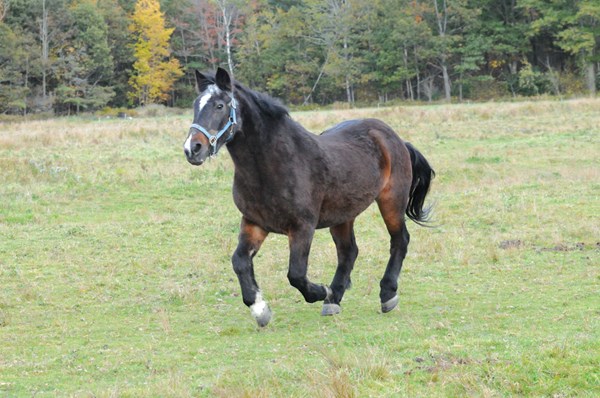 Credit: © Dusty Perin Turnout, preferably for 24 hours a day, and exercise are essential to keeping horses active in their golden years.
Credit: © Dusty Perin Turnout, preferably for 24 hours a day, and exercise are essential to keeping horses active in their golden years.Q: I have had my horse for about three years now, and he is getting up in age (he’s about 17 years old.) How do I know how hard to push him without pushing him too hard? I want to keep us both challenged without overstepping our boundaries, but how do I find out where those boundaries are?
KARYN MALINOWSKI, PhD
A: Technically, your horse is still middle-aged. Horses live about one year for every three years that humans live, so he’s only 51 in human years. Scientists don’t consider horses “aged” or “old” until they turn 20 because we see no signs of deteriorating aerobic ability before then. In fact, there are no measurable differences in aerobic capacity between middle-aged horses and younger horses. Many horses compete well into their teens, even at the top levels of their sports. (For example, Anky van Grunsven’s 2012 Olympic mount, Salinero, was 18 when they won the team dressage bronze medal.)
Treadmill studies show that as horses age beyond 20, their maximum aerobic capacity declines. We think this is caused by a reduction in the heart’s stroke volume (the amount of blood pumped from one ventricle of the heart with each beat). This means the heart has to work harder to pump blood through the body during exercise. As a result, older horses cannot perform as fast or for as long as young and middle-aged horses. During strenuous exercise, they also have trouble thermoregulating (controlling their core body temperature). In treadmill tests, we have observed the core body temperature of older horses rising faster than it does in younger horses. Interestingly, even after strenuous exercise, older horses still recover very quickly. In these same treadmill tests, their core temperature returned to normal 10 minutes after exercise stopped, just as did their younger counterparts’ temperature.
Because thermoregulation is more of a challenge for older horses during exercise, they have a higher risk of overheating. It is important to monitor their exertion levels (by observing breathing rate and sweat quantity) and to avoid riding on especially hot and humid days.
Having said that, even older horses have a tremendous ability to exercise. The aerobic capacity (the “VO2 max,” which measures the body’s ability to utilize oxygen) of a 20-year-old horse is still two times higher than that of an elite Olympic marathon runner. Horses are designed to continue exercising late into their lives. Our prime example at the Rutgers Equine Center is Lord Nelson, a 40-year-old Quarter Horse who still gallops up to the gate every morning for breakfast.
The biggest problems we see in aging horses actually result from too little exercise and too much food. Similar to aging humans in this country, our elderly horses suffer from obesity and other symptoms of metabolic syndrome, such as laminitis. Keeping horses active with exercise and turnout (preferably 24 hours/day) is essential in these later years. Like human senior citizens, older horses can improve their aerobic performance—and lose body fat, which is key to better health—with carefully planned training and conditioning programs. The horses in our exercise studies also exhibit increased flexibility and a more exuberant, happy attitude in general.
Depending on your horse’s history, he is more likely to experience orthopedic issues before any loss of aerobic capacity. If you notice signs of arthritis—mild soreness and stiffness the day after a demanding ride—reduce his workload for a few days. He may enjoy a liniment rubdown (over his stiff joints) and might also benefit from a little anti-inflammatory medication, such as bute, before and/or after harder workouts.
Eventually, as your horse progresses through his 20s, you will need to take his exercise level down a notch. For example, if you were foxhunting over 4-foot jumps, you could gradually transition to hilltopping and jumping 2-foot jumps. But try to keep doing whatever activity he enjoyed most in his earlier days. With luck, he will continue performing happily for another decade or more—and may still be going strong like Lord Nelson at 40!
Professor Karyn Malinowski is the director of the Equine Science Center at Rutgers, The State University of New Jersey. For the last 20 years, she and her colleagues have focused their research efforts on the physiology of performance horses, particularly aging ones. The center also uses its model environmentally conscious facility and interactive website (www.esc.rutgers.edu) to engage a broader audience and promote greater interest in equine science. “Professor emeritus” Lord Nelson’s blog in the website’s Kid’s Corner is one of its most popular features. The site also includes a video game, “Exercising Horsepower”, in which players conduct their own scientific studies on horses exercising on a virtual treadmill.
A rider herself, Dr. Malinowski has tried “just about every discipline there is” and continues to foxhunt at age 60 on a 20-year-old horse. She says that Magic is “happy, aerobically fit for his age—and I’m having a blast riding him!” For even more excitement, she races harness horses. She is the second-fastest woman to drive a pacer at Meadowlands Racetrack in East Rutherford, New Jersey.
This article originally appeared in the February 2014 issue of Practical Horseman.
Save










